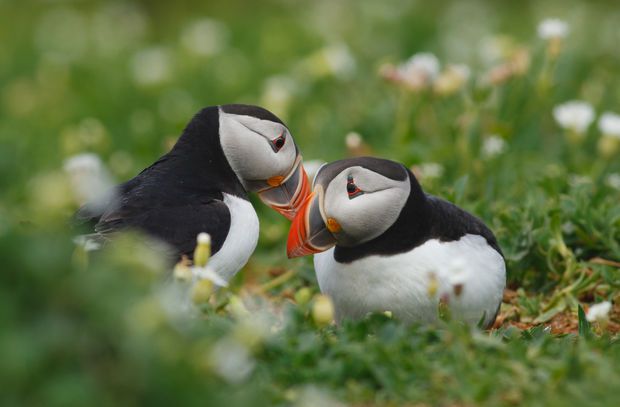To some they’re known as the ‘clowns of the sea’ and to others ‘sea parrots’ but, to all, there’s something about the puffin’s mix of colourful cuteness and doleful majesty that’s so delightful. And, as they spend much of the year out in arctic waters it can be difficult to catch a sighting of them, adding to their mystery. However, on April 14 of each year 200,000 of the birds descend on Lovund – a small grass-covered island off Norway’s coast – to nest. It’s such a regular occurrence that you could set your calendar by it, making it one of the best ways of spotting both adult and baby puffins. The islanders even have a word for the event – Lundkommardagen – which they celebrate as the first day of summer.

Puffins arrive in huge numbers on April 14 every year
A visit to Lovund, then, is a special experience. Its small village – where the church’s spire is the highest construct – is set against a giant sloping butte that’s been weathered into dramatic twists and folds. Its forest carpet has even been mentioned in Old Norse literature. Today, the island’s moss-embroidered scree is the ideal burrowing habitat for puffins. Using their sharp claws and large beaks, they can dig up to three feet between rocks and into dirt to form cosy dens for just one egg. And, perhaps taking note of their Scandinavian host’s progressive values, both parents take turns incubating the egg over the period of around seven weeks. And, once it hatches, they even share feeding duties. Puffins mate for life.
That’s not to say you’ll arrive to find brightly coloured beaks hidden behind crevices. Puffins line their nests with everything from grass to seaweed, meaning plenty of foraging trips for mum and dad alongside the usual fishing expeditions. You can, therefore, spot them throughout their stay on the island, however, the undisputed highlight of their visit is their arrival when 100,000 puffin pairs fill the skies and busy themselves preparing their new homes. It’s also a prime time to catch couples ‘billing’ whereby they rub their beaks together to show affection.

Once puffins mate, they stay partners for life
You’ll also find the puffins at their beautiful best. Few know, thanks to their remote sea home, that puffins’ beaks turn grey in winter as their yellow-tinged orange rings only return in the spring; it’s a colourful display that impresses both mates and camera lenses alike. While it’s possible to catch glimpses of their activity from the island itself, for the best views, take to the waters on a boat tour to watch the puffins fly overhead and to get the best vantage points of their nesting habits.
If you fancy heading further afield, Gjesvæarstappan – a collection of uninhabited islands just off from Norway’s northernmost tip – is especially rewarding; on April 14th each year, almost one million puffins flock to its craggy shores. If this all sounds interesting, Best Served is able to tailor-make a Norway holiday to suit your tastes, even last-minute. Perhaps combine puffins with whales on a trip out of nearby Andenes, where sightings of the world’s largest mammal are so prolific that tours come with sighting guarantees.
For more wildlife holiday ideas, click here.
